Bee’s Paradise
We celebrated Equinox in the vineyards 21 days ago and it is starting to look and feel like Spring. Equinox is the day when the hours of daylight equal the hours of darkness. Because the Earth tilts, the days grow longer after Winter Solstice but the quickening change and the longer days become undeniable and exciting after Equinox. The cherries have been blooming for a week now and the daffodils, too. The old-timers used to gauge the blossoming of the vines by the cherry blossom. We’ll see. Tulips are starting to show their vibrant colors and there is a buzz of activity when the sun comes out. Deciduous trees are starting to take the edge off of what has been a long grey winter with all their fresh green shoots.
Yesterday the sun came out and so I turned off my computer and went for a walk around our REX HILL vineyard. The vineyard was just radiating life and color. Not more than a week ago, the vineyard looked like the picture on the left. Today it looked like the picture on the right!
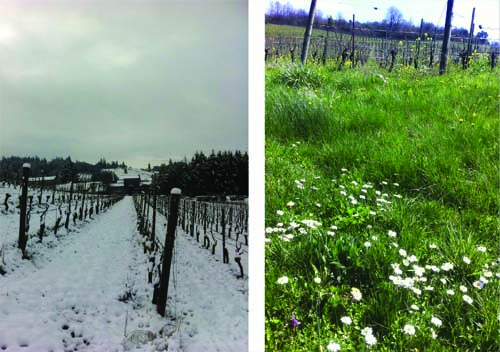
 It is a bee’s paradise in our Biodynamically farmed estate vineyard. Just in this photo there are five plant species flowering, all providing them with nectar and pollen. The white flowers are English daisies (Bellis perennis,) the purple flower in the left hand corner is Red Dead Nettle (Lamium purpureum)and just beyond the English daisies are Dandelions (Taraxacum officinale), Cat’s-ear (Hypochaeris radicata) and Field Mustard (Brassica campestris). When I walked up to the first stand of Field Mustard, I noticed there was a bumble bee, a honey bee and a mason bee all within a yard of each other. That’s cool!
It is a bee’s paradise in our Biodynamically farmed estate vineyard. Just in this photo there are five plant species flowering, all providing them with nectar and pollen. The white flowers are English daisies (Bellis perennis,) the purple flower in the left hand corner is Red Dead Nettle (Lamium purpureum)and just beyond the English daisies are Dandelions (Taraxacum officinale), Cat’s-ear (Hypochaeris radicata) and Field Mustard (Brassica campestris). When I walked up to the first stand of Field Mustard, I noticed there was a bumble bee, a honey bee and a mason bee all within a yard of each other. That’s cool!
All of these plant species I identified using the book Northwest Weeds: the Ugly and Beautiful Villains of Fields, Gardens and Roadsides by Ronald J. Taylor. It’s a nice simple book that catalogs most of the common weeds in the Pacific Northwest. These plants are found in a book about weeds but to me they aren’t weeds. To me, these plants play an important role in the farm’s ecosystem. They add biodiversity, provide habitat and a food source for a wide range of organisms. They also help reduce compaction from machinery, prevent erosion and help keep the soil healthy. In summary, it’s good to remember how important plants are to us and what they do for the environment. Next time you get out your hoe or your herbicide have another think about why you’re trying to kill that plant. It could be doing you a favor but you’ve just never realized it.
Biodynamic Farming: following the moon
What most of us may not notice is that like the sun, the moon has a similar pattern when traveling through the night sky. The difference between the sun and the moon is that the moon’s cycle is only 27.3 days instead of one year. When the moon is progressively getting higher in the sky, we say the moon is ‘ascending’ and when it is getting lower in the sky we call this ‘descending.’ We believe these rhythms are akin to the seasons. For example, the ascending period is like spring & summer and the descending is like fall & winter. During the ascending period, we believe there is a subtle shift of the energy to what is above the ground. During the descending period, the energy is shifted inward to the soil and roots. By altering certain practices to work with these lunar rhythms, we are trying to work with the rhythms of life and reinforce these rhythms to the organisms on the farm.
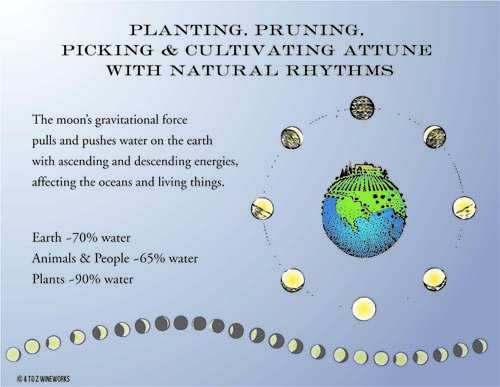
Some examples of how we work in the vineyard with these rhythms are:
Descending moon (energy directed inward to soil and roots)
1. Pruning the vines
2. Planting dormant vines
3. Making and spreading compost
4. Cultivating
5. Spraying preparation 500 and barrel compost*
Ascending moon (energy directed above the ground)
1. Spraying preparation 501*
2. Harvesting fruits, vegetables and flowers
3. Sowing seeds – Although germination happens below the ground, there is an upward striving in the plant
*Biodynamic Preparations
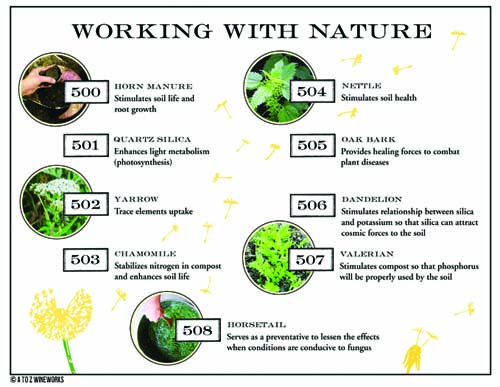
Biodynamic Farming: following the sun
Biodynamic farming is complex, sometimes hard to explain and sometimes hard to quantify. It involves many areas: preparations, compost, biodiversity and an awareness of the rhythms happening all around us. I want to talk a little about using a Biodynamic calendar and the intention behind our practices during certain periods on the calendar by highlighting the thoughts of Rudolf Steiner and all those who have continued what he started. The biggest thing to understand is that we believe the moon has an influence on animals, plants and the activities we perform on the farm.
We all follow the sun over the course of the day: it rises in the east, reaches its peak at midday then descends to the west. In summer, the sun’s arch is much higher than it is in winter. In the northern hemisphere, the arch gets progressively higher every day from December 21st (winter solstice) until it reaches its highest arch on June 21st (summer solstice) from then on the arch slowly lowers again. We call this cycle one year and it coincides with the earth doing a full rotation of the sun. When the sun slowly gains height in the sky, we experience spring and then summer. When the sun begins to descend, we experience autumn and winter. During spring and summer, the earth ‘breathes out.’ Plants focus their energy on new growth and reproduction. In fall and winter, the earth ‘breathes in’ and plants refocus their energy towards the soil mostly on root development and storing energy in these organs until the cycle starts again.
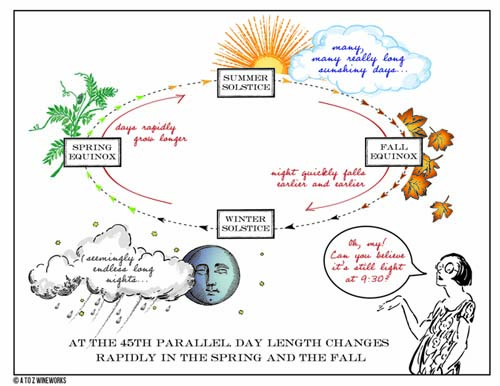
Macro, Meso and Microclimates
The first viticulture book I read was written by an Australian named John Gladstone, Viticulture and Environment. It goes into depth defining climate, what influences climate, climatic indices and their relative effect on viticulture. The book also compares climates from wine growing regions from around the world. He does a fantastic job of defining climate by spatial scale.
Why does this matter? In any given vintage there is talk about the macroclimate but the day-to-day considerations and efforts to farm the best quality fruit deal with the meso and microclimates. The meso and microclimates dictate how each site is farmed, taking into consideration the climactic characteristics that make each site unique.
There are three spatial scales that are generally recognized: Macro, Meso and Mircroclimates.
Macroclimate
The macroclimate broadly defines the climate of a region. Most of the time this describes the general climate pattern from a recording station. Its scale is from tens of miles to hundreds of miles. Examples of macro climates are the Willamette Valley (figure 1), the Rogue Valley and Eastern Oregon.
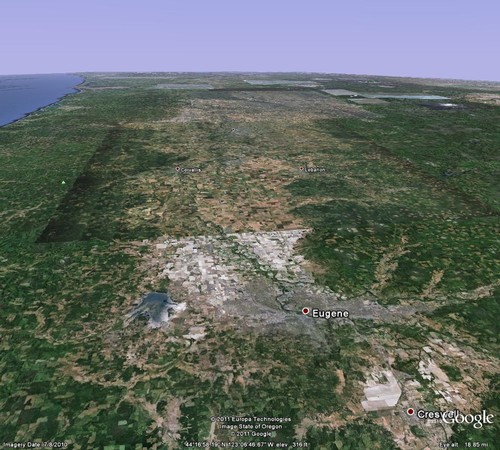
Mesoclimate
Mesoclimate is described as the climate of a site as influenced by elevation, aspect, slope or distances from large bodies of water. Its scale extends from tens of yards to miles depending on the consistency in topography. Mesoclimate is often referred to as Topoclimate for it’s the topographic influence on a site’s climate (figure 2).
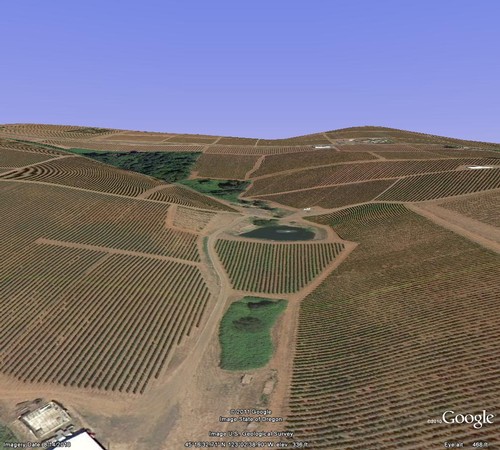
Microclimate
Microclimate is the smallest scale of climate. Its scale is from tens of yards to millimeters. Examples include conditions behind windbreaks, near trees (figure 3), around the vine canopy and inside the canopy. Humans manipulate vine canopy microclimate with trellis systems, shoot positioning, leaf and lateral removal (figure 4). Manipulating canopy microclimate alters disease pressure, fruit composition and fruitfulness of shoots.
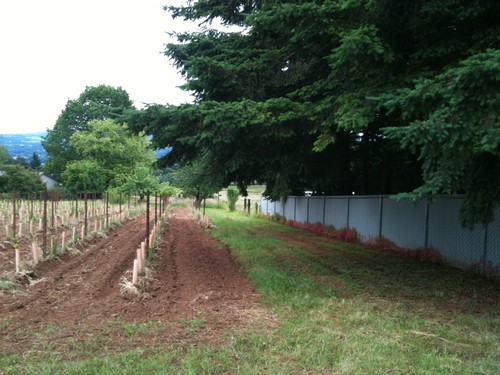
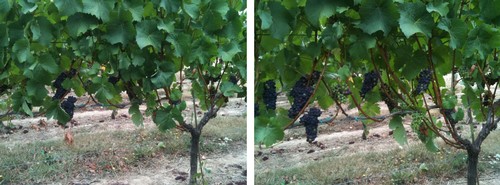
Columbia Gorge
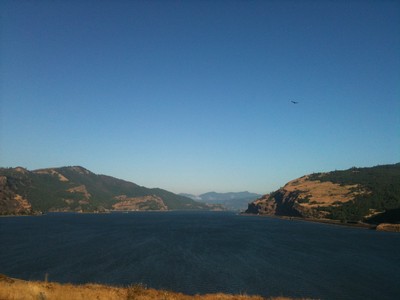
Probably one of my favorite place in Oregon is the Columbia Gorge. The fast flowing rivers, the dramatic cliffs, water falls and the forever blue sky’s never cease to take my breath away. As you drive east from Portland the landscape changes from dense conifer to woodland forest then to semi arid scrubland. This change in landscape starts around Hood River and continues to become more dramatic as you drive east. The influence of the Cascade mountain range is more than just physical presence. When the frontal systems roll in from the Pacific Ocean the moisture laden air has to ascend the mountains to continue east. As it ascend the temperatures get colder until the water turns from vapor to rain. This type of rain is dubbed Orographic. One thing that is typical of Orographic rainfall is that one side of the mountain range is always wetter than the other. In this case Portland is on the wet side and Hood river is at the cusp of the dry side.
Today I was visiting one of our growers in Mosier which is about 10 miles east of Hood River. Thanks to the Cascade mountain range the climate out there is warmer, drier and sunnier than the Willamette valley. These factors; sunshine and temperature make it great for growing grapes of many origins. It has enough sunshine hours and heat units to ripen Pinot Noir, Chardonnay, Sauvignon Blanc, Merlot, Syrah and Tempranillo just to name a few.
Summer may be warmer and sunnier than the Willamette valley but winter is much colder. The vines come out of dormancy about a week later. Spring conditions help the vines overtake the WV so fast that flowering in Pinot Noir was a week ahead! Right now they are about 2 weeks ahead and I was seeing the first signs of veraison. The berries are softening, accumulating sugar and changing color. Last year veraison started around the same time 8.18.2011. If it takes approximately 40 days from 50% veraison to harvest we should be picking in the first week of October.
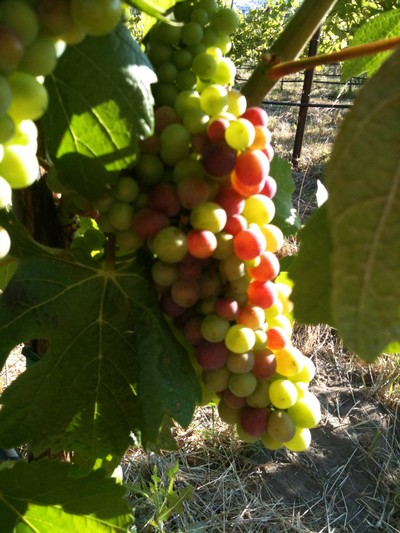
Grape berry development
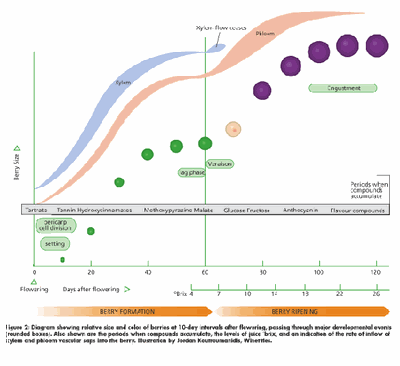
I’m going to give you a brief update on berry development to date here in Oregon.
Currently the North Willamette is coming toward the end of phase 1 in berry development: flowering to lag phase. In the first stage of berry development (phase 1) the berries are growing from cell division. Canopy size, water and nutrient availability influence the amount of carbohydrates available for cell division. Vines with big canopies, lots of water and nutrients will produce large berries with high cell numbers. conversely small canopies and stressed vines will produce small berries with low cell numbers. Equally influential on berry size is seed number. Seeds make auxin and gibberellins (plant hormones) making the berry a stronger sink for assimilates. Lower seed numbers per berry result in less cell division. High numbers of seeds produce greater amounts of hormones stimulating cell division. The final size of the berry is limited by the number of cells in the berry and the extent of expansion and or the degree of shrinkage (from dehydration) in phase 3.
At lag phase, phase 2 of berry development, the size of the cluster is said to be half that at harvest. Growers use this metric to estimate the potential yield of their vineyards and how they are going to crop thin. The problem with this metric is that its very hard to determine exactly when lag phase is without continually measuring berry volume and waiting for it to plateau. Some models suggest lag phase is 55 days after first bloom, other models say its at 1200 GDD (this is measurement of heat units for a growing season) and finally some people go by seed hardening. What am i going to do this year? Seeing that we’ve had seed hardening for over a week and we’re only 45 days post bloom im going to wait until next Monday. Currently we’re at 1140 GDD for the North Willamette and i think we should be right on 1200GDD when i start sampling.
http://www.winebusiness.com/weather/index.cfm?weatherLocationId=22
Now the Rouge Valley is ahead of the North Willamette by 2-3 weeks and some of the vineyards are starting to go through veraison (phase 3). Veraison is when the grapes change from being hard, green and acidic to soft, getting color and accumulating sugar.
For more on berry development.
http://www.extension.org/pages/31096/stages-of-grape-berry-development
Bloom!
July first rolled around and so has summer! The temperatures have been consistently in the 80’s for the last 6 days bringing flowering with it!
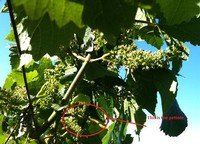 Things to think about when the vine is blooming.
Things to think about when the vine is blooming.
It’s a great time for assessing the vines nutrient status. We take plant tissue and send it to a A and L laboratory to analyze the concentration of different nutrients. The tissue we use is the petiole ( connects the leaf to the shoot). For standardizing the procedure we take the petiole located opposite the basal cluster. Tissue analysis at this time (60-70% cap fall) is great for giving you the vines micronutrient status. Whereas sampling at veraison is best for understanding your macro nutrient status.
Micronutrients:
Iron (Fe), Zinc (Zn), Copper (Cu), Manganese (Mn), Molybdenum (Mo), Boron (B), Aluminium (Al), Sodium (Na).
Common Micronutrient deficiencies in Oregon are Boron and Zinc. If there is a deficiency in a micronutrient it will be applied to the canopy in what’s called a “foliar application”.
Macronutrients:
Nitrogen (N), Potassium (K), Phosphorous (P), Sulfur (S), Calcium (Ca), Magnesium (Mg).
Macro-nutrients problems are best fixed through ground applications.
Other things to think about.
Botrytis! When the flower cap falls off it leaves a scar around the base of the ovary. If this scar isn’t protected there is potential that botrytis will infect the tissue. It will sit there until conditions are right for growth. This is called a latent infection.
Botrytis will also colonize any dead flowering tissue that is left in the cluster. Again it will sit there waiting for conditions to become right for further colonization/infvection. What can we do about this? We have to spray the flowers once 85% of the caps have fallen off.
This year in our organic sites we are trying two products Actinovate and Whey as a combination. Actinovate is a bacteria (Streptomyces) antagonist of botrytis and whey acts as a food source for the bacteria (Streptomyces). Trials performed in growers vineyards last year with the USDA showed that this was as effective as some of the synthetic products.
http://www.gwrdc.com.au/webdata/resources/files/BotrytisFactSheet.pdf
Time to harvest.
In Oregon it usually takes 100-110 days from bloom to harvest. If we call bloom today at the REX HILL home vineyard we will be harvesting some time between the 14th and 24th of October.
Who wants to guess the harvest date?
Growth and Cover Crops
- Bud break finished about 2 weeks ago and we are starting to see some leaves unfold and inflorescence becoming visible. Vineyards vary in phenology from 1 leaf separated through to 4 leaves separated.
- Development is slower than I would like due to the cool wet temperatures (La Nina pattern)
- We are seeing some minor mite damage causing Short Shoot Syndrome (SSS).
- Over winter the mites live in the bud scales and emerge at the same time as the shoots.
- They tend to feed on the growing shoots causing stunted, zig-zagging growth, scaring in the internodes and leaves distortion.
- The shoots will out grow the mite’s ability to keep the shoot stunted but to do that we need nice warm weather.
- Damage is generally sporadic
Figure 1.
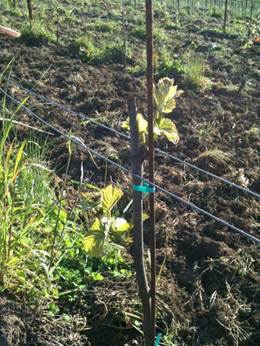
Figure 2. Short shoot syndrome
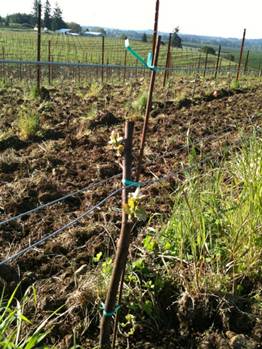
The two vines above were right next to each other in a young Pinot Noir block (4W) at Jacob Hart Vineyard. One showing strong healthy shoot growth and the other suffering from short shoot syndrome. We have treated this block with a light application of sulfur try and knock down the mite population. We will monitor the progress of effected vines and mite populations using double sided sticky tape wrapped around the trunk.
For those that are interested this website offers more information.
http://wine.oregonstate.edu/files/files/Short%20Shoot%20Symptoms%20of%20Grapes.pdf
Cover Crops
Fall cover crops
- We are now starting to work in our fall cover-crops of Winter Rye Grain and Vetch.
- These are planted in the rows that we cultivate to hold the soil in place over winter
- We also get the benefit of nitrogen fixation from the vetch
- Both these cover crops produce a great amount of biomass which is worked into the soil to increase organic matter content, soil life and quality.
- In the less vigorous areas we planted a combination of the two plants to increase soil fertility and possibly vigor (added nitrogen from the vetch)
- In the more vigorous areas we didn’t use vetch because we didn’t want the added nitrogen further increasing vigor.
Figure 3. Winter Rye grain planted in the Pinot Gris block at Jacob Hart.
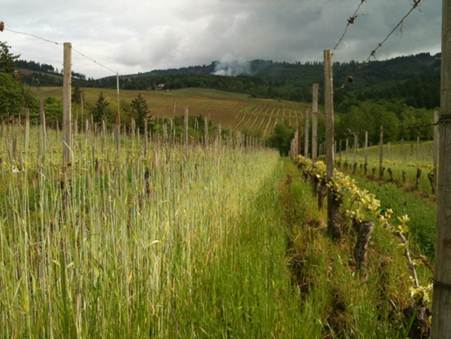
Spring Cover crops
- We have planted buckwheat and wildflowers at many of our sites: Jacob Hart, REX HILL, Pearl, Sims, Foley and Domain Margelle.
- We have planted these for their flowering qualities. These plants will provide nectar for a variety of insects and birds increasing the diversity of life within our vineyards.
- Why buckwheat? Once mature it will flower for a long period of time producing large quantities of nectar. Buckwheat has been shown to increase numbers of predatory beneficial insects and reduce pest populations to below economic thresholds.
Figure 4. Recently germinated buckwheat at REX HILL vineyard.
Phenological Stages
Viticulturists like to talk about phenology and phenological stages. Phenology is the study of the sequence of plant growth and investigates a plant’s reaction to the environment and attempts to predict its behavior in the new environment. A widely adopted system for recording grapevine phenology is the modified EL system. Below is a snapshot of the EL system.
Most Northern Willamette Valley vineyards are between stages 3 and 4. Lower altitude sites like REX HILL and Jacob Hart Vineyards are mostly stage 4. Historical average budbreak dates for the Willamette Valley are mid April. Why are we around two weeks behind? Because spring has been much cooler than normal due to the La Nina ocean currents in the Pacific Ocean.
Below are historical average monthly temperatures for the Portland area and what has been recorded this year, 2011.
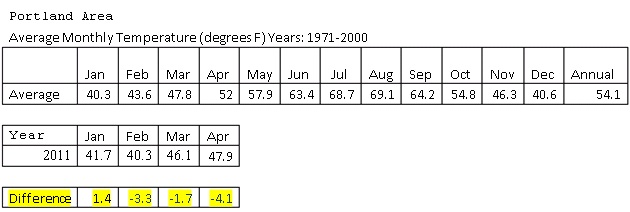
As you can see the months of February, March and April have been colder than average. April’s monthly average temperature was a chilly 4.1 degree F less than average and the predictions moving forward look similar. This is NOAA’s statement for May, June and July.
“THE TEMPERATURE OUTLOOK FOR MJJ 2011 IS, OVERALL, CONSISTENT WITH LA NINA CONDITIONS. PROBABILITIES OF BELOW NORMAL TEMPERATURES ARE ENHANCED FROM THE PACIFIC NORTHWEST EASTWARD ACROSS THE NORTHERN ROCKIES THROUGH THE GREAT LAKES REGION, INTO THE MIDDLE ATLANTIC COAST REGION. THE OCN PREDICTS PROBABILITES FOR ABOVE NORMAL TEMPERATURES ACROSS THE INTERIOR SOUTHWEST.
THE SEASONAL PRECIPITATION OUTLOOK FOR MJJ 2011 CALLS FOR GENERALLY ABOVE-MEDIAN PRECIPITATION IN NORTHERN SECTIONS OF THE CONUS. BELOW MEDIAN PRECIPITATION IS LIKELY ACROSS THE SOUTH-CENTRAL U.S. AND IN PARTICULAR, TEXAS AND LOUISIANA. IN SPITE OF THE EXPECTED WEAKENING OF LA NINA TO NEUTRAL STATUS BY JUNE 2011, THE ABNORMALLY WET SOILS IN NORTHERN SECTIONS OF THE CONTIGUOUS UNITED STATES, AND ABNORMALLY DRY SOILS IN THE SOUTH, ARE LIKELY TO LEAD TO A CONTINUATION OF COOL, WET CONDITIONS IN THE NORTH AND WARM DRY CONDITIONS IN THE SOUTH. “ http://www.cpc.ncep.noaa.gov/products/predictions/90day/seasglossary.html#la%20nina
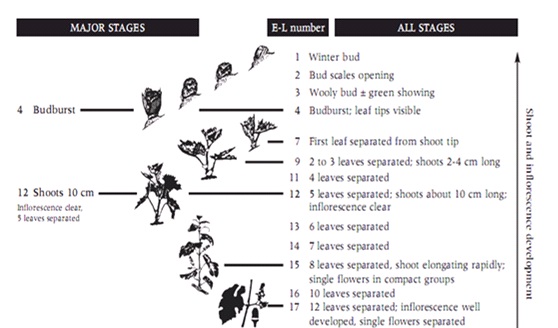
Pruning 101
Pruning: The act of trimming or removing what is superfluous. The main purpose of pruning grape vines is to regulate crop load and vine balance. Vines can self regulate shoot numbers based on their capacity however humans like to control and manipulate the growth of vines for qualitative reasons. Pruning is performed during the winter months when the vine is dormant. Sometimes pruning is performed at the start of spring when the buds are swelling to shock the vines and delay bud burst. This is common practice in areas/sites that are prone to spring frosts in an effort to reduce the risk of crop loss.
Two main types of pruning:
Cane
Usually 1-4 canes retained depending on plant spacing, vine capacity and target yield. A replacement spur on each side of the head gives rise to next years fruiting cane and replacement spur. Old cordons and unwanted canes are removed manually from the trellis system.
Cane pruning is more commonly practiced in cool climate viticulture. It will produce higher numbers of clusters/shoot and potentially larger clusters than spur pruning. Therefore in years of poor set there will be more fruit than a spur pruned vine.
Cool cloudy springs inflorescence primordial development* particularly at proximal buds. This means the buds closer to the vines have less potential clusters/shoot or smaller potential clusters than those further up the cane. Cane pruning is more expensive, requires more skill and is less mechanized.
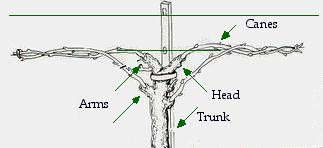
Spur
Spurs are canes cut back to 2 buds along a permanent cordon. Spurs are spaced approximately 3-4 inch apart but more buds are retained per spur or spurs density is changed depending on vine capacity and target yield.
Spur pruning is more commonly practiced in warmer climates where vines have better proximal bud inflorescence primordial development. This system is more easily mechanized, costs less and requires less skill.
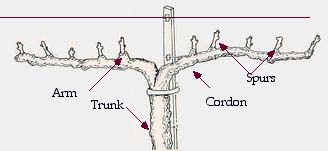
There are many variations on these two pruning techniques to different training/trellis systems.
* Inflorescence primordia are miniscule undeveloped clusters inside either the primary or the secondary buds. The term for the singular is primordium. Their size is related to the number of flowers with potential to transform into a berry and, therefore, to final cluster size. Inflorescence primordial development is temperature and light dependent thus buds further up the canes develop later in spring when light and heat is more abundant.
Recent Posts
-
October 12, 2018
-
June 7, 2018
-
October 30, 2017
-
October 23, 2017
-
September 13, 2017
-
April 17, 2017
-
July 21, 2016
-
June 2, 2016
-
May 25, 2016
-
May 18, 2016
Blog Categories
Blog Archives
Our Writers
- Leanne Bellncula (2)
- Shelli Brinson Fowler (1)
- Tom Caruso (2)
- Ryan Collins (20)
- Bill Hatcher (10)
- Deb Hatcher (2)
- REX HILL (59)
- Kelly Irelan (1)
- Carrie Kalscheuer (3)
- Jonathan Lampe (3)
- Karina Lopez (1)
- Meredith McGough (1)
- Katie McLennan (2)
- Charlotte Mischel (2)
- Karen Peterson (2)
- Olivier Prost (2)
- Tom Reed (1)
- Emily Sadler (1)
- Sam Tannahill (2)
- Mike Willison (4)


